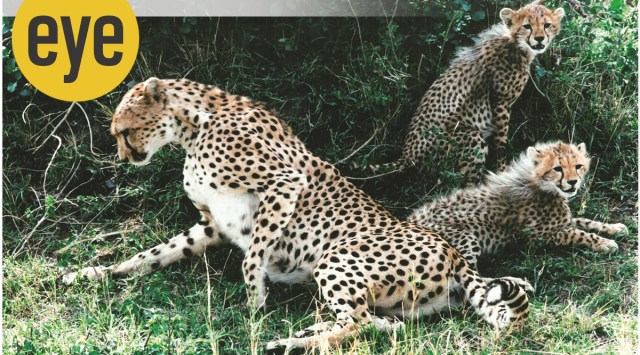Latest Comment
Post Comment
Read Comments
 Cheetah with cubs in Kenya’s Masai Mara (Courtesy: MK Ranjitsinh)
Cheetah with cubs in Kenya’s Masai Mara (Courtesy: MK Ranjitsinh)‘Seeing the cheetah in Kuno National Park is a dream come true’: MK Ranjitsinh
From a cushion cover to a photograph to a figurine, all of which share space with other wild things, the cheetah lives on in every corner of MK Ranjitsinh’s living room in Delhi. Much like it has lived in his imagination ever since he was a boy of 10 or so. “As a boy, I had heard that the last cheetah had been shot and this must have been in either 1948 or 1949. I was an avid reader of wildlife literature and I thought why can’t we bring the cheetah back from somewhere. It was a dream and it’s now come true. I always say the most difficult thing to kill is a good idea,” says Ranjitsinh, who belongs to the royal family of Wankaner in Gujarat and who made bringing cheetahs to India his life-long mission.
Translocation of cheetahs: How to Befriend a Bilai Nahar
 The Namibian cheetahs will first be put into a quarantine enclosure for a month before being moved into a five sq km-long enclosure, and then, finally, let out in the open jungle (Photo source: Wikimedia Commons)
The Namibian cheetahs will first be put into a quarantine enclosure for a month before being moved into a five sq km-long enclosure, and then, finally, let out in the open jungle (Photo source: Wikimedia Commons)
Wearing a gamcha around his neck that has ‘Cheetah Mitra’ embossed on it alongside a photo of the big cat, Lala Ram Adivasi sits amongst a group of villagers at Sesaipura gram panchayat, about 20 km away from Tiktoli entry gate of Kuno-Palpur National Park, trying to lay out the difference between a lion, a leopard and a cheetah.
Why the world of music has had a long, tumultuous relationship with Queen Elizabeth II
 The cheeky Sex Pistols poster from the ’70s
The cheeky Sex Pistols poster from the ’70s
Last week, when Queen Elizabeth II, England’s longest reigning monarch, passed away, the British national anthem — God save the queen — was replaced with God save the king, after Charles III took the throne. Her death has raised questions around constitutional monarchy and obeisance to the royals. But this is hardly new. For years, artistes have expressed their dissent through music.
What if plants could truly think and feel?
 A rose by any other name would smell as sweet (Photo credit: Ranjit Lal)
A rose by any other name would smell as sweet (Photo credit: Ranjit Lal)
Spiders dream, dogs shed tears, elephants grieve (and never forget), chimpanzees make tools, crows invent games and dolphins know who they are (and would probably take selfies if given smart-phones and have millions of followers on social media). The list of animals that we call “sentient” grows day by day. Even crocodiles shed tears, though granted they may be the same kind as politicians shed. And, very soon, I think the same is going to be discovered about plants. Already, there are people out there hugging trees and playing classical music (no hip-hop please) to their plants and swearing that when you rip a carrot out of the soil it screams (They do not).
‘Photographing is a form of friendship’: Dayanita Singh
 Museum Bhavan, 2017, installed in Agra for a private event (Courtesy: Dayanita Singh)
Museum Bhavan, 2017, installed in Agra for a private event (Courtesy: Dayanita Singh)
Sunday at a seaside lounge overlooking the Gateway of India. Tourists teem outside, patrons brunch inside, boats bob on a glinting sea. Taking it all in is Delhi-based photographer Dayanita Singh, 61, seated at a sunlit window. She has called for decafs and eggs on avocado toast as a treat. A celebration is in order. A retrospective, the launch of a new “photo novel”, and winning the prestigious Hasselblad Award — all have happened in under a year.
How theatre director KP Suveeran’s encounters with social inequalities shapes his award-winning works
 A scene from KP Suveeran’s play Bhaskara Pattelarum Thommiyude Jeevithavum. (Courtesy: Teamwork Arts)
A scene from KP Suveeran’s play Bhaskara Pattelarum Thommiyude Jeevithavum. (Courtesy: Teamwork Arts)
When one of the country’s prestigious theatre events, the Mahindra Excellence in Theatre Awards (META), returned before a live audience in July, it marked a fightback for the struggling art form. On show were four plays that had been created in the years preceding COVID-19 and had won top honours at META in 2020. Bhaskara Pattelarum Thommiyude Jeevithavum, by a maverick theatre director from Kerala, KP Suveeran, was among the selections.
‘1984 is in our collective subconscious’: Diljit Dosanjh
 A still from the film Jogi.
A still from the film Jogi.
After your National Award-winning movie, Punjab 1984 (2014), what made you revisit the 1984 anti-Sikh riots in your latest Netflix release, Jogi?
The story of Punjab 1984 is different from Jogi’s. Punjab 1984 is based in Punjab while the story of Jogi unfolds in Delhi, three months after that incident (Operation Blue Star). This story was not told earlier. It’s definitely the subject that made me say yes to the movie immediately after Ali sir (director and co-producer Ali Abbas Zafar) approached me. Iss mudde pe film banana aapne aap mein hi ek badi baat thi (Making a film on this subject is in itself a big deal). However, what you refer to as riots, is actually genocide. Riots take place when it’s a clash between two groups. In this case, a particular community was targeted.


